Text
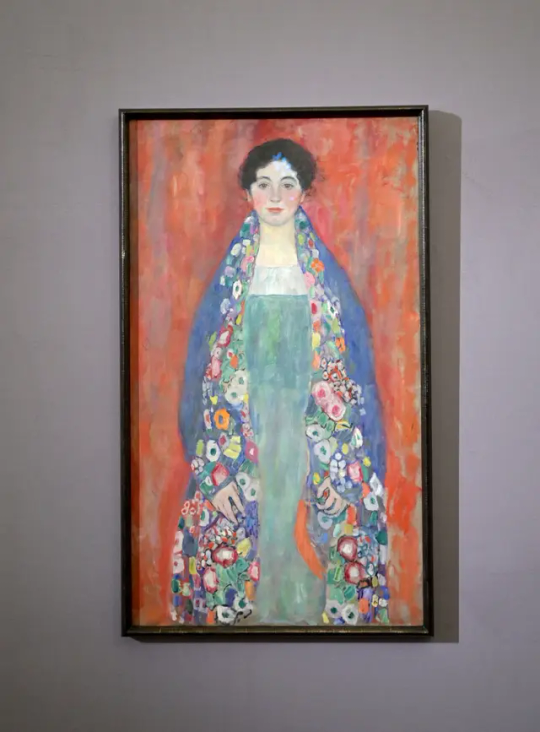

Gustav Klimt Portrait Missing for a Century Sells for $32 Million
A portrait by Gustav Klimt that was unseen for almost a century has sold for $32 million – the bottom end of its pre-auction estimate.
The “Portrait of Fräulein Lieser,” thought to be one of the Austrian painter’s final works, created huge excitement in the art world, but it ended up selling at the lower end of its valuation of €30 million-€50 million ($32 million to $53.4 million).
Bids started at €28 million and the work went for a hammer price of €30 million. This does not include the auction house’s fees.
The sale price was less than half that fetched by another Klimt painting – “Dame mit Fächer” (Lady with a Fan) – in London last year. The last portrait completed by Klimt became the most expensive artwork ever to sell at a European auction, when it sold for a £85.3 million ($108.4 million).
The “Portrait of Fräulein Lieser” had long been considered lost, according to Vienna auction house im Kinsky. However, it recently emerged that it had been privately owned by an Austrian citizen.
“The rediscovery of this portrait, one of the most beautiful of Klimt’s last creative period, is a sensation,” the auction house said in a press statement on its website prior to its sale on Wednesday afternoon.
The intensely vivid and colorful piece had been documented in catalogues of the artist’s work, but experts had only seen it in a black and white photo.

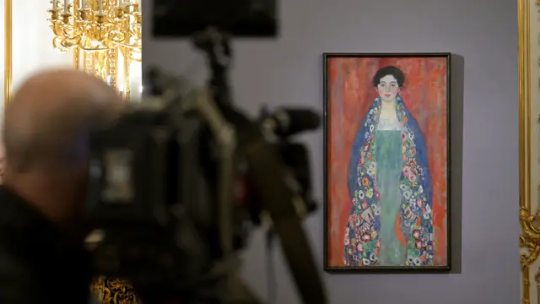

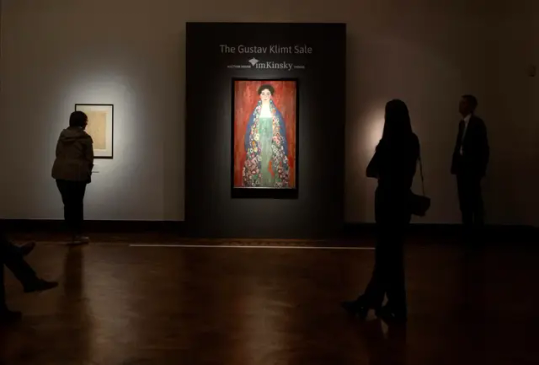
The sitter is known to have been a member of a wealthy Austrian Jewish family who were then part of the upper class of Viennese society, where Klimt found his patrons and clients. Nevertheless, her identity is not completely certain.
Brothers Adolf and Justus Lieser were leading industrialists in the Austro-Hungarian empire. Catalogues of Klimt’s work state that Adolf commissioned the artist to paint his teenage daughter Margarethe Constance. However, new research by the auction house suggests Justus’ wife, Lilly, hired him to paint one of their two daughters.
The statement on the auctioneer’s website reveals that the sitter – whoever she was – visited Klimt’s studio nine times in April and May 1917. He made at least 25 preliminary studies and most likely began the painting in the May of that year.
“The painter chose a three-quarter portrait for his depiction and shows the young woman in a strictly frontal pose, close to the foreground, against a red, undefined background. A cape richly decorated with flowers is draped around her shoulders,” the auction house said.


It added: “The intense colors of the painting and the shift towards loose, open brushstrokes show Klimt at the height of his late period.”
When the artist died of a stroke the following February, the painting was still in his studio — with some small parts not quite finished. It was then given to the Lieser family.
Its exact fate after 1925 is “unclear,” according to the auction house.
“What is known is that it was acquired by a legal predecessor of the consignor in the 1960s and went to the current owner through three successive inheritances,” the statement said.

The painting was to be sold on behalf of its Austrian owners, who have not been named, along with the legal successors of “Adolf and Henriette Lieser based on an agreement in accordance with the Washington Principles of 1998,” the auction house said.
Established in 1998, the Washington Principles charged participating nations with returning Nazi-confiscated art to their rightful owners.
Claudia Mörth-Gasser, specialist in modern art at im Kinsky, explained the situation in an email.


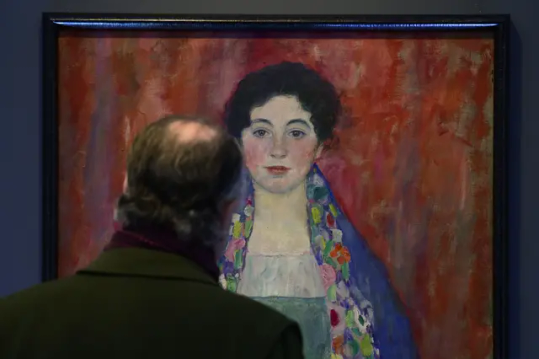
She said the auctioneer checked the painting’s history and provenance “in all possible ways in Austria,” adding: “We have checked all archives and have found no evidence that the painting has ever been exported out of Austria, confiscated or looted.”
But by the same token, she added: “We have no proof that the painting has not ever been looted in the time gap between 1938 and 1945.”
And this is the reason “why we arranged an agreement between the present owner and all descendants of the Lieser family in accordance to the ‘Washington Principles,’” she said.
Klimt’s portraits of women “are seldom offered at auctions,” the press release stated. It continued: “A painting of such rarity, artistic significance, and value has not been available on the art market in Central Europe for decades.”
By Lianne Kolirin.

#Gustav Klimt#Gustav Klimt 'Portrait of Fräulein Lieser'#Gustav Klimt Portrait Missing for a Century Sells for $32 Million#austrian artist#painter#painting#art#artist#art work#art world#art news
7 notes
·
View notes
Text


George Washington's 250-Year-Old Cherries Found Buried at Mount Vernon
Archaeologists found something incredibly rare in the cellar of George Washington's home at Mount Vernon: Two intact jars of cherries buried in the basement of the first U.S. president's house.
Nick Beard, project archeologist at Mount Vernon, said on Tuesday that he had been excavating the basement "for quite a while" when he saw the lip of one of the jars in November.
When the bottle started to peek out from the earth, he proceeded carefully but said he didn't think it would turn out to be anything out of the ordinary, adding that it's common to find wine bottles and glasses at the site about 15 miles south of Washington, D.C.
In fact, Beard stepped away from the bottles to help on a more immediate project. Only when he returned several weeks later did he realize what he discovered.
As he worked, more and more glass became exposed. He tried to wiggle the glass out of its resting place, but when he did his fingers got a little wet.
That's when he noticed whatever he was working on was full of liquid.
"Which means if it's that full of liquid then it has to be intact enough to hold that liquid," said Beard. "That's not common, so that immediately got me excited."
Uncovered jars reveal centuries-old cherries
When Beard further revealed the jars, he called other archeologists to come check his findings.
The jars were fully excavated on March 22. The cherries were removed from the bottles to help preserve the glass, but after April 30, the glass will be sent off for conservation. Its contents will be sent to a lab for analysis and be tested in a controlled environment by specialists, according to a press release from Mount Vernon.
"It's extraordinary," Jason Boroughs, principal archaeologist at Mount Vernon, saying something similar has only happened twice in Virginia in the past six decades:
The latest discovery is a part of the privately funded $40 million Mansion Revitalization Project at Mount Vernon.

What was in the jar?
Beard and Boroughs said that cherries and a mystery liquid were found in the jar. And the cherries, Boroughs said, actually look like cherries, even after hundreds of years.
"They're plump, they have flesh, they have pits and stems," Boroughs said. "They don't look as if they've been sitting in a bottle for 250 years, although they have."
The liquid inside even smelled like cherry blossoms, according to Mount Vernon.
The cherries in the bottles were probably dry when they were buried, Boroughs said.

While the archeologists know what the cherries are, the liquid is still a bit of a mystery.
Lily Carhart, curator of the preservation collections at Mount Vernon, said it's possible the groundwater got into the bottle after the cork that sealed it deteriorated.
The liquid still needs to be tested, Boroughs said. And there is a small possibility it could've been a type of alcohol, like a brandy or cognac.
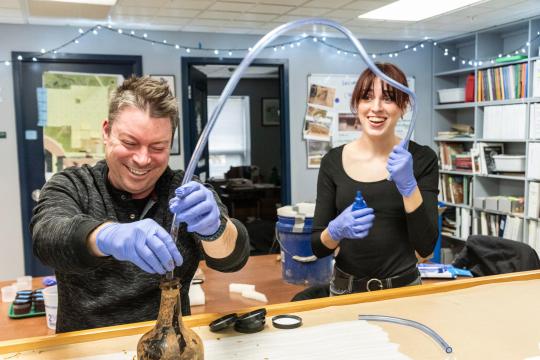

Why were the cherries buried?
Enslaved laborers picked the cherries, wiped them off to avoid condensation and placed them into the jar. Then, that jar was corked and buried sometime between 1758 and 1776, when both George and Martha Washington were living at the home, according to Boroughs.
He added that the method would've kept the fruit inside the bottle preserved for up to a year. It was one of the most popular ways to preserve berries and its how folks in colonial America preserved food before there were refrigerators.
"It pretty much keeps them isolated and sealed from the atmosphere, from air and from fungus and other things that could attack" he said.
According to Boroughs, the cherries were supposed to be served on George Washington's dinner table, but instead were forgotten and buried under a brick floor that was placed in the 1770s, sealing its fate as a sort of a "time capsule."



Can you still eat the cherries?
"You would not want to put that close to your face," Carhart said about the cherries.
Boroughs said that it could actually be possible to eat them, but "nobody wants to try."
Why is this discovery significant?
Boroughs said the discovery is remarkable because he "can't count the number of times 18th-century food remains have been found intact" the way the cherries were.
"We're the first people to touch these objects since they were put in the ground by an enslaved person," Boroughs said.
While the discovery itself is incredible, the archeologist said the stories that can be uncovered from it are just as amazing.
"We think of these items sort of as the material bits of lives that we can recover from the ground," Boroughs said. "These bottles tell stories. They're attached to people who had real lives and if we know how to put the pieces together, we can piece together something about their lives."
Beard added that it feels "surreal" to have such an "immediate connection with the people that lived back then."
By Julia Gomez.



#George Washington's 250-Year-Old Cherries Found Buried at Mount Vernon#Mount Vernon#George Washington#ancient artifacts#archeology#archeolgst#history#history news
29 notes
·
View notes
Text

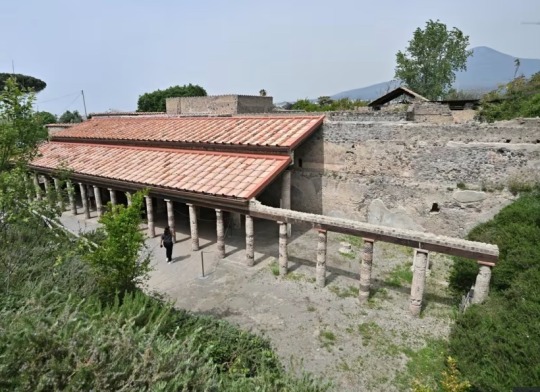
‘Ancient Roman’ Solar Roof Tiles Power Pompeii Villa
Ancient Roman ruins at Pompeii have been fitted with invisible solar panels, in a move that will contribute to the archaeological site’s sustainability efforts and cut costs. The innovative panels, which blend into the background by imitating traditional materials, were installed on the House of Cerere, on a thermopolium — a Roman snack bar — and on the House of the Vettii, which recently reopened following 20 years of restoration work.
“They look exactly like the terracotta tiles used by the Romans, but they produce the electricity that we need to light the frescoes,” said Gabriel Zuchtriegel, the director of the archaeological park of Pompeii, in a press release.
Each year, 3.5 million tourists explore the vast ruins of the ancient Roman city, which was buried by the eruption of Mount Vesuvius in 79 AD. But due to Pompeii’s size, energy bills are expensive and conventional methods of providing power across the site can threaten its appearance.

“Pompeii is an ancient city which in some spots is fully preserved,” Zuchtriegel said. “Since we needed an extensive lighting system, we could either keep consuming energy, leaving poles and cables around and disfiguring the landscape, or choose to respect it and save millions of euros.” The new technology will help the archaeological site to cut energy bills and make it more enjoyable, he added.
The invisible solar panels — or “traditional PV tiles” as they are technically known — were created by the Italian company Dyaqua. They can be designed to appear like stone, wood, concrete or brick, and hidden on walls, floors and roofs, according to Elisabetta Quagliato, whose family owns Dyaqua, in the press statement.
“We are an archaeological site but we also want to be a real-life lab for sustainability and the valorization of intangible heritage,” Zuchtriegel said. “Our initiative is not merely symbolic. Through the million tourists who visit us every year, we want to send a message to the world: cultural heritage can be managed differently and in a more sustainable way.”


Other locations in Italy using the invisible solar technology are the commune of Vicoforte in Italy and, soon, Rome’s contemporary art museum Maxxi. Public buildings in Evora, Portugal, and Split, Croatia will also install the panels, according to the press statement.
Pompeii’s recent use of these panels is just the beginning, Zuchtriegel said. “From now on, we will be taking this solution into account for all future renovation and restoration projects.”
By Garry Shaw.

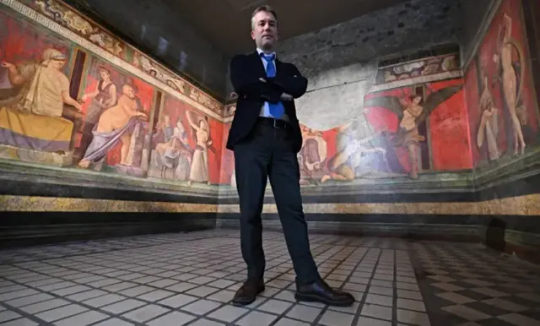
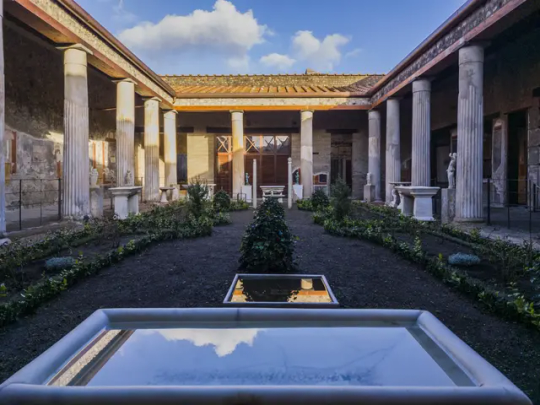
#‘Ancient Roman’ Solar Roof Tiles Power Pompeii Villa#House of Cerere#House of the Vettii#thermopolium#terracotta tiles#solar power#frescoes#mount vesuvius#ancient artifacts#archeology#archeolgst#history#history news#ancient history#ancient culture#ancient civilizations#roman history#roman empire#roman art
50 notes
·
View notes
Text

Sunflower
A pretty sunflower in Attleboro, Massachusetts.
📸 flickr
#flickr#original#original post#original photography#original photography on tumblr#tumblr#artists on tumblr#nature#nature lovers#nature photography#my photography#yellow#flower#sunflower#pretty#beauty#beautiful#blueiscoool#blueiskewl
19 notes
·
View notes
Text



A Restauration Patinated and Gilt-Bronze Sunflower Clock
Circa 1820
#A Restauration Patinated and Gilt-Bronze Sunflower Clock 1820#clock#antique clock#time#time pieces#sunflower#art#artist#art work#art world#art news#antique
42 notes
·
View notes
Text
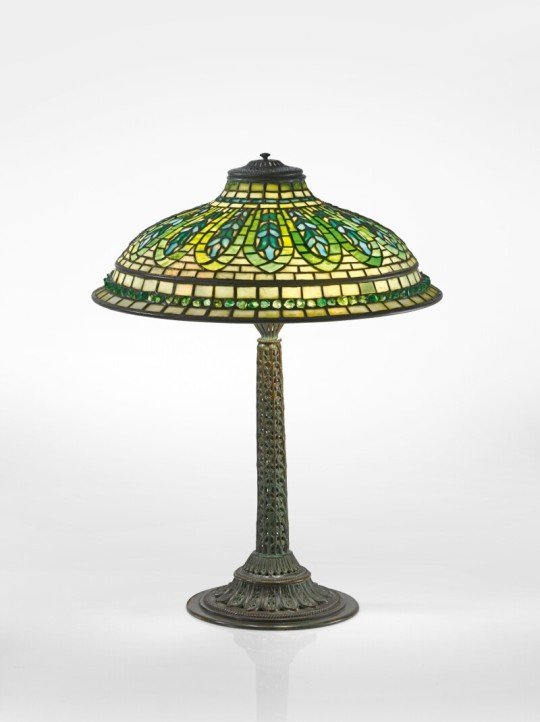

Tiffany Studios
"Gentian" Table Lamp
Circa 1905
#Tiffany Studios#Tiffany Studios “Gentian” Table Lamp 1905#lamp#glass#tiffany glass#art#artist#art work#art world#art news#art deco#pretty#beauty#beautiful#1900s#1900s art#1900s style
23 notes
·
View notes
Text
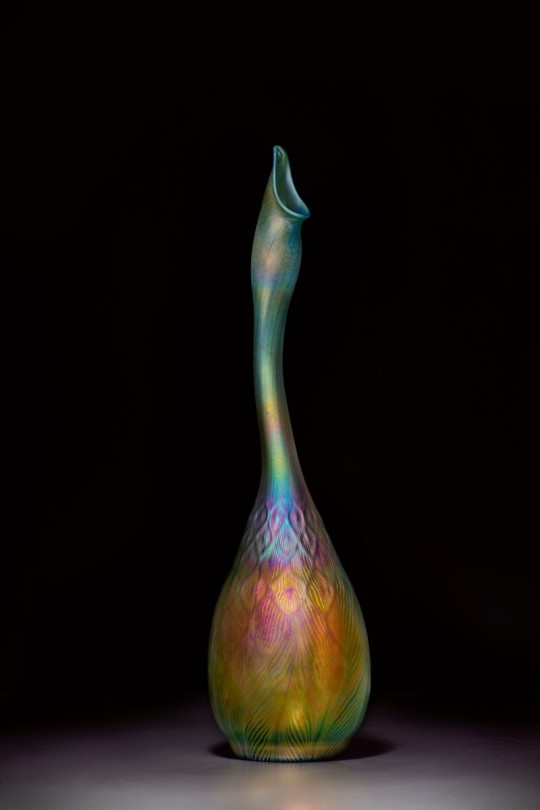


Tiffany Studios
"Peacock Feather" Gooseneck Vase
Circa 1897-1899
#Tiffany Studios#Tiffany Studios “Peacock Feather” Gooseneck Vase 1897-1899#vase#glass#favrile glass#tiffany glass#art#artist#art work#art world#art news#art deco#pretty#beauty#beautiful
34 notes
·
View notes
Text

On The Hunt
A Ukrainian Su-25 attack aircraft pilot looking sharp while hunting Russians.
#ukraine#russia#russian war on ukraine#fighter pilot#fighter jet#fighter plane#fighter aircraft#Su-25#the front line#war#world at war#weapons#on the hunt
20 notes
·
View notes
Text
Russian Tu-22M3 Bomber Shot Down
A Russian Tu-22M3 supersonic bomber was shot down by Ukraine with a modified S-200 anti-air missile as it was returning to base after launching cruise missiles at Odesa. The crash site is at least 400km away from the frontline in the Stavropol region of Russia.


27 notes
·
View notes
Text


2,500-Year-Old Greek-Illyrian Helmet Discovered in Croatia
Archaeologists discovered a Greek-Illyrian helmet dating 2,500 years in very good condition on Croatia’s Pelješac peninsula.
The same team that found the Greek-Ilyrian helmet in 2020, in the same place, has found the next helmet, which according to the first analysis is older than the one found earlier.
The previous example most likely belonged to a member of the warrior elite who was interred there because it was discovered in a grave with pieces of iron weapons.
Archaeologists think the recently discovered helmet may have been a votive deposit because it was discovered in a dry stone-walled addition to a grave.
Greco-Illyrian type helmets originated in Peloponnese, Ancient Greece, where it likely evolved from the Kegelhelm (or Kegel type) of the Archaic Period.
The Greek-Illyrian helmet is extremely rare
Both of the helmets found are of different types and dates: The helmet discovered in 2020 was of a type commonly used in Greece and Illyria in the 4th century BC. It was an open-faced helmet with a rectangular cross-section for the face and decorative edges.
The newly found helmet is thought to date from the 6th century BC and is extremely rare. Finding two different Greek-Illyrian helmets at one site is unprecedented.
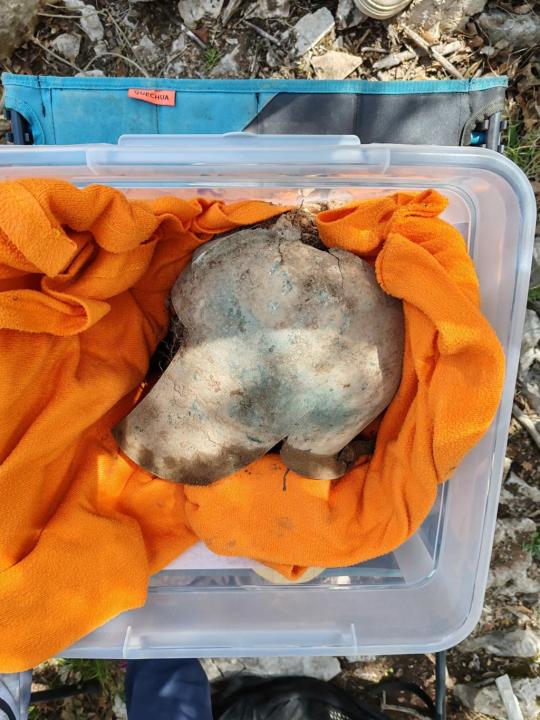

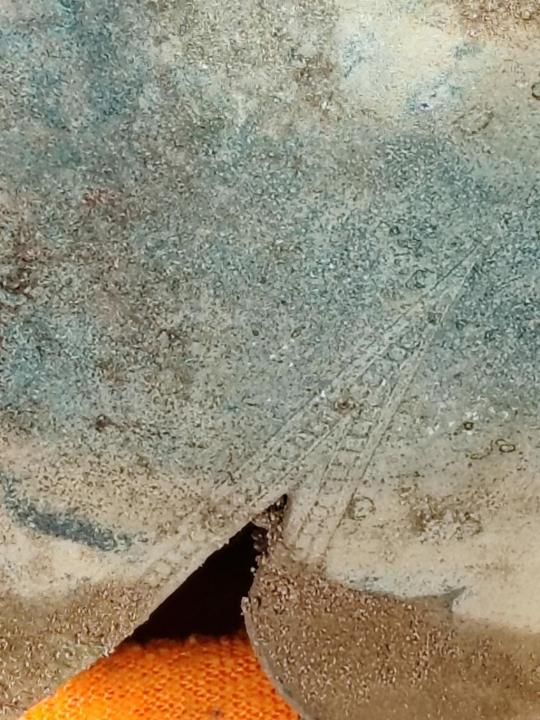
This find, along with a wealth of clothing, jewelry, and burial artifacts unearthed since the excavations began, greatly expands our knowledge of the funeral practices of Illyrian communities in the latter half of the first millennium BC.
The Illyrians were a group of Indo-European-speaking people who inhabited the western Balkan Peninsula in ancient times. They constituted one of the three main Paleo-Balkan populations, along with the Thracians and Greeks.
“What is very interesting is that two different types appear here in the same place, which speaks of a continuity of power of the respective community. These helmets have always been a symbol of some kind of status and power,” said Professor Hrvoje Potrebica, from the Department of Archeology of the Faculty of Philosophy in Zagreb.
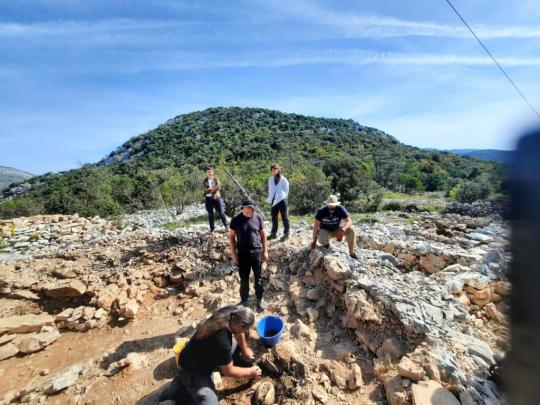
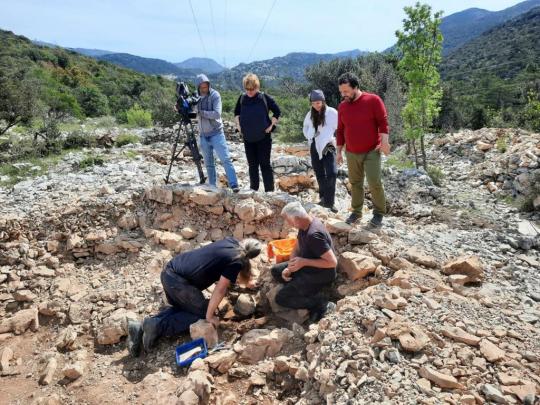
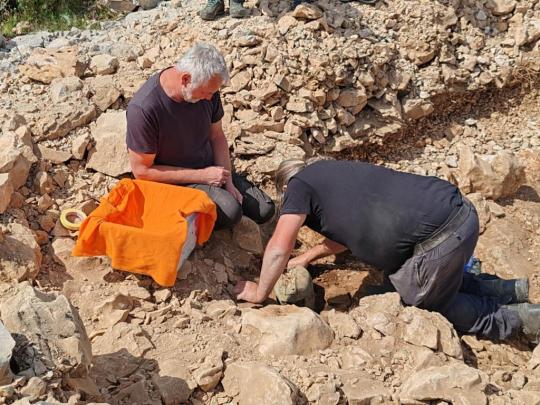
Speaking on the discovery, a representative from the Dubrovnik Museum said: “Along with numerous finds of jewelry, costumes and grave goods, this find of a helmet contributes in many ways to the knowledge of funeral rituals of Illyrian communities in the second half of the last millennium BC, and it ranks the area of Pelješac as one of the most important archaeological zones of the eastern Adriatic coast.”
Recently, archaeologists in Southern Italy have unearthed several significant artifacts, including two helmets, fragments of weapons and armor, and pottery shards, at an archaeological site in the ancient Greek city of Velia.
By Tasos Kokkinidis.
#2500-Year-Old Greek-Illyrian Helmet Discovered in Croatia#ancient Greek city of Velia#ancient artifacts#archeology#archeolgst#history#history news#ancient history#ancient culture#ancient civilizations#greek history#greek art
80 notes
·
View notes
Text

Gigantic Marine Reptile Fossil Found by 11-Year-Old Girl and Father
A massive jawbone found by a father-daughter fossil-collecting duo on a beach in Somerset along the English coast belonged to a newfound species that’s likely the largest known marine reptile to swim in Earth’s oceans.
Scientists consider the blue whale, which grows up to 110 feet (33.5 meters) long, to be the largest known animal ever to exist on the planet. But it’s possible that the 202 million-year-old reptile, known as an ichthyosaur or “fish lizard,” may have rivaled it in size.


The ichthyosaur’s jawbone, or surangular, was a long, curved bone at the top of the lower jaw just behind the teeth, and it measured more than 6.5 feet (2 meters) long. Researchers believe the creature, named Ichthyotitan severnensis, or “giant fish lizard of the Severn” in Latin, was more than 82 feet (25 meters) long, or the length of two city buses.
Justin and Ruby Reynolds, who live in Braunton, England, recovered the first pieces of the jawbone in May 2020 as they looked for fossils on the beach at Blue Anchor, Somerset. Ruby, 11 at the time, spotted the first chunk of bone, and then she and her dad found additional pieces together.
By Ashley Strickland.
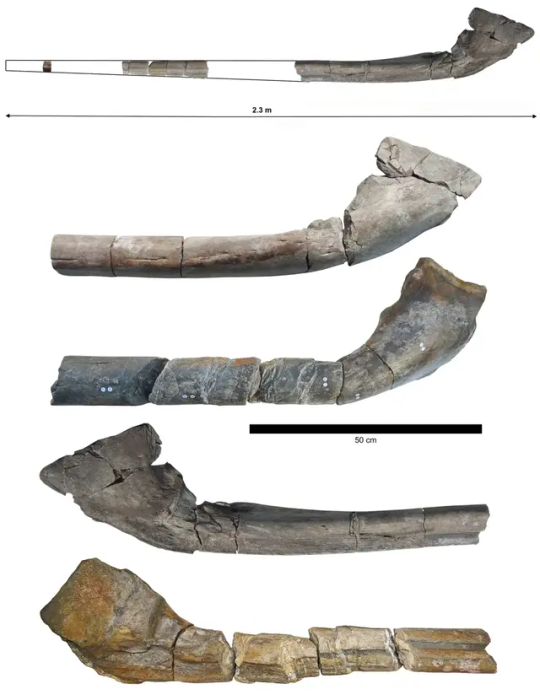
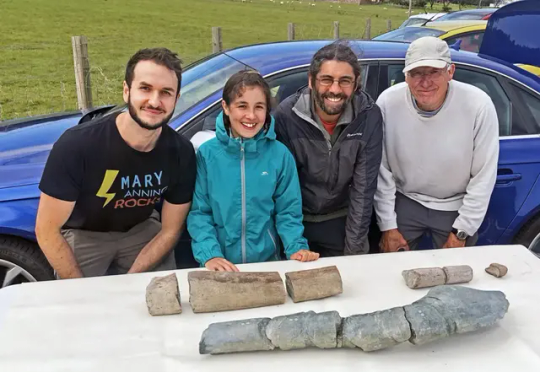
#Gigantic Marine Reptile Fossil Found by 11-Year-Old Girl and Father#Somerset#ichthyosaur#Ichthyotitan severnensis#giant fish lizard of the Severn#fish lizard#ancient artifacts#archeology#archeolgst#history#history news#ancient history#fossils
23 notes
·
View notes
Text
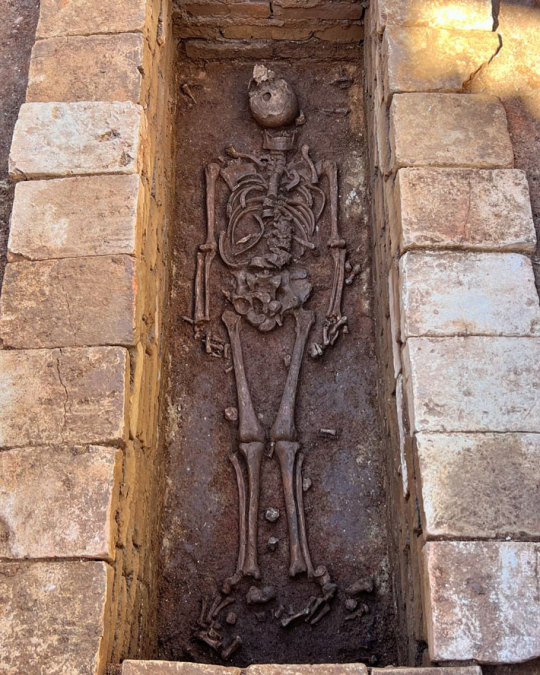
Three Roman Graves Uncovered in Portugal
Three burials dating to the 5th or 6th century AD have been unearthed in the ancient Roman city of Ossónoba in Faro, southern Portugal.
The Ossónoba’s first archaeological evidence dates back to the 4th century B.C., when the Phoenicians settled in the Western Mediterranean. The city was then called Ossónoba From the 2nd century B.C. until the 8th A.D. the city was under Roman and Visigoth dominance being afterwards conquered by the Muslims in 713.
A team of archaeologists from ERA Arqueologia discovered ancient Roman structures and the remains of a man, woman, and child while conducting excavations over a 5,000 square meter area that will eventually house a real estate development.
The excavations, which took place before a construction project, revealed the grave of a man whose skeleton was complete and who would have been between 39 and 45 years old, as well as a young woman under the age of 25, and a baby who would have been no more than six months old, according to archaeologist Francisco Correa.
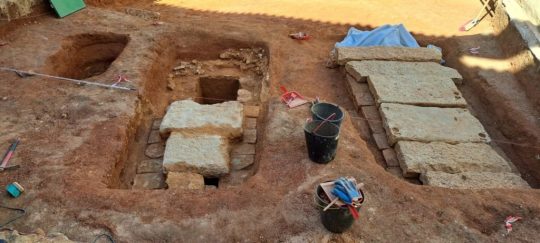
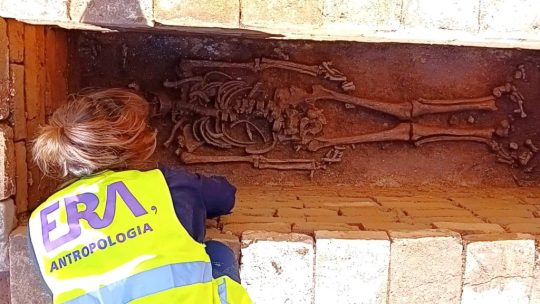

Francisco Correia, the project’s head archaeologist, said in a statement that the discoveries were made in an old truck repair workshop and are believed to date from the 5th or 6th century.
The tombs appear to have been looted in the past to steal “small bracelets, necklaces, and rings,” according to anthropologist Cláudia Maio. The tombs indicate that the people may have had “some economic status” as they were not simply placed in open graves but instead buried in carefully built graves.
The proximity of the three people’s graves seems to indicate that they were family members, though the team cannot be certain of that. “But we cannot say anything for sure,” the anthropologist said.
To learn more, the researchers hope to be able to provide more precise answers through DNA tests and isotopic analysis techniques used to determine population movements and dietary habits from chemical traces in ancient human remains.
This latest archaeological discovery did not come as a surprise to archaeologists, who had already led similar works which resulted in the discovery of a Roman game artifact believed to date back to the first century AD in 2020.

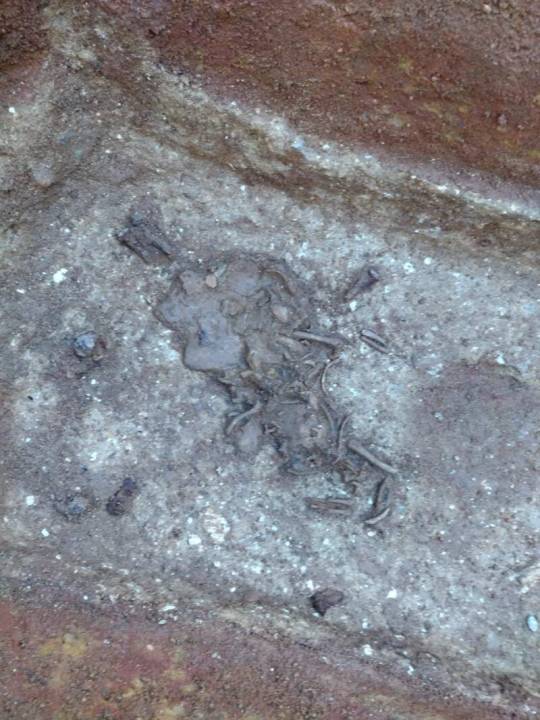

“We know that we are in an area with archaeological potential where there is a 17th-century convent (of Santo António dos Capuchos) to the west, and to the east lies the area where the mosaic of the Ocean God (Deus Oceano), now a national treasure, was found,” he said.
What did come as a surprise to archaeologists was the location of the tombs.
“Based on previous studies, this would have been an area that was possibly residential or more linked to industrial activities. There are many traces of salterns. Largo da Madalena would have been the entrance to the urban area of the city of Ossónoba. The identified graves are in the Figuras area, near Teatro Lethes, close to the Ermida de São Sebastião and the Pavilion of Escola D. Afonso III. This area is almost within the urban fabric,” the archaeologist explained, adding that this illustrates both the “growth and decline of Ossónoba.”
The graves of the man and the woman “were sealed with limestone slabs,” believed to be reused parts from “some of the most emblematic buildings that would have been here in the area,” he believes.
According to the project manager of ERA Arqueologia, who was co-responsible for the work, in addition to the graves, hundreds of small pieces were also discovered which suggest that there may also have been a mosaic there.
The researchers also recovered Roman artifacts in the area, including ceramics, bone dice, nails, pins, a spoon, possible evidence of a dye factory, and coins minted during the reign of Constantine the Great, between A.D. 306 and 337.
Cover Photo: Roman mosaic of the god Oceanus, part of the ancient city of Ossónoba, the modern town of Faro, in Portugal.
By Leman Altuntaş.
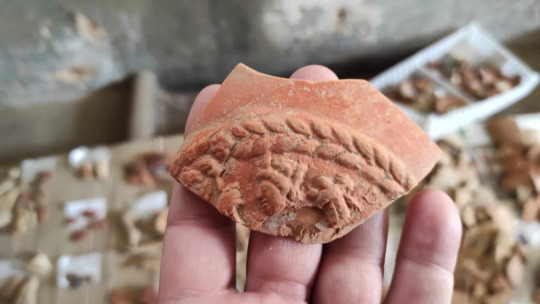

#Three Roman Graves Uncovered in Portugal#Roman city of Ossónoba in Faro#ancient grave#ancient tomb#ancient artifacts#archeology#archeolgst#history#history news#ancient history#ancient culture#ancient civilizations#roman history#roman empire#roman art
100 notes
·
View notes
Text
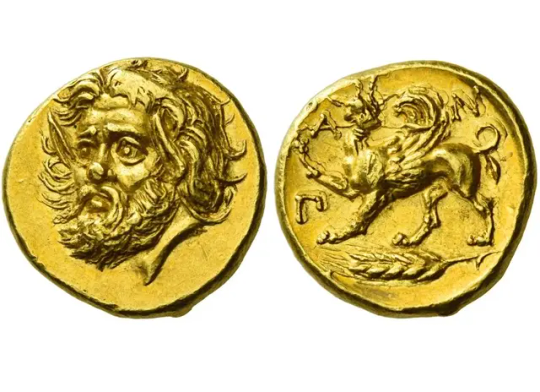
A 2,000-Year-Old Gold Greek Coin Sells for $6 Million at Auction
The coin once belonged to the State Hermitage Museum until it was sold off by Joseph Stalin.
A private collector has spent a pretty penny to get their hands on a 2,000-year-old gold Greek coin.
Known as a Panticapaeum stater, after the ancient Greek city in modern-day Crimea, the coin went for $6 million at Numismatica Ars Classica in Switzerland making it the most expensive ancient coin ever sold at auction.
The soaring price has been attributed to the coin’s quality, rarity, and the fact the supply of similar specimens is extremely limited with most already housed inside museums.
“I am extremely pleased with the phenomenal result the sale of the Panticapaeum stater achieved at our latest auction in Zurich,” Arturo Russo, co-director at Numismatica Ars Classica, said in a statement. “This is a sign the whole market for numismatics is flourishing, and is especially strong for ancients at the moment.”
The coin was minted circa 340–25 B.C.E. and features a wide-eyed satyr on the obverse and that of a griffin gripping a spear in its beak on the reverse. The presence of the satyr, a mischief-maker in Greek mythology that resembles a man with horse ears and a tail, is thought to reference king Satyros I, who ruled a Greco-Scythian empire in eastern Crimea from 432 to 389 B.C.E.
The sharp details make numismatists confident the coin is the work of a master engraver. Unlike similar coins, this Panticapaeum stater features the satyr facing three-quarters to the left, as opposed to facing fully left, a detail experts believe was altered in an attempt to follow contemporary fashions.
The coin was long part of the State Hermitage Museum’s collection, but was sold off in 1934 as part of Stalin’s push to sell works of art to raise foreign currency to fund domestic industrial growth. The coin was acquired by Charles Gillet, a French industrialist who focused on collecting rare books, furniture, and antiquities, including coins.
The previous record for most expensive ancient coin sold at auction was one of only three known “Ides of March” coins, which was minted in 42 B.C.E. and commemorated the assassination of Julius Caesar. It sold at Roma Numismatics auction house for $4.2 million in 2020, though, as it turned out, with falsified provenance.
By Richard Whiddington.

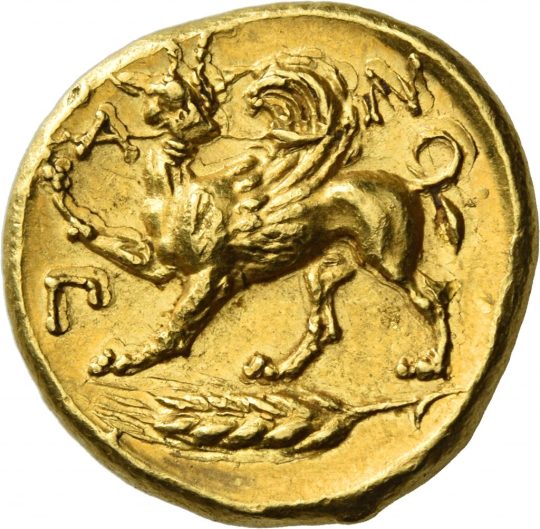
#A 2000-Year-Old Gold Greek Coin Sells for $6 Million at Auction#Panticapaeum stater#king Satyros I#gold#gold coin#ancient coins#ancient artifacts#archeology#archeolgst#history#history news#ancient history#ancient culture#ancient civilizations#ancient greece#greek history#greek art
45 notes
·
View notes
Text

Ancient Noble Tomb Found in China
A noble tomb has been found in a cemetery dating back to the Six Dynasties period (222-589) in the city of Zhenjiang, east China's Jiangsu Province, according to the city's cultural relics and archaeology institute.
The owner of the tomb, named Zhao Xuanzhi, was the uncle of an emperor during the Southern Dynasty (420-589).
Archaeologists found a bronze seal in Tomb No. 6 that helps identify the owner of the tomb. "The bronze seal found in Tomb No. 6 has been confirmed as Zhao Xuanzhi's personal seal. The age of the tomb is consistent with historical records," said Li Xidong, deputy director of the city's cultural relics and archaeology institute.
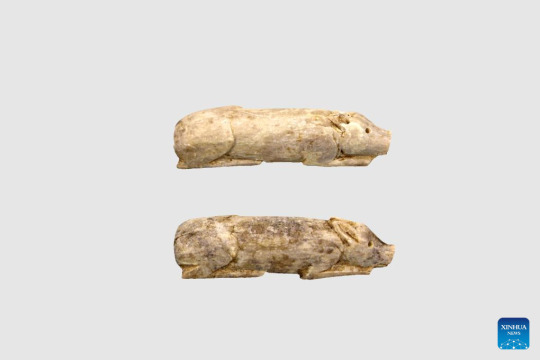

Twenty funerary objects were also unearthed from Tomb No. 6, mostly distributed near the altar at the front of the tomb chamber.
Archaeologists found 13 tombs during recent excavations, seven of which were brick chamber tombs of aristocrats from the Eastern Jin Dynasty (317-420) to the Southern Dynasty, while six others were pit tombs of civilians from the Ming and Qing Dynasties (1368-1911).
Archaeologists said most of the tombs found in the cemetery of the Six Dynasties period belong to the Eastern Jin Dynasty, which provides evidence of people at that time moving from the north to the south. The discovery provides important clues and material data for the study of ethnic migration in Chinese history.
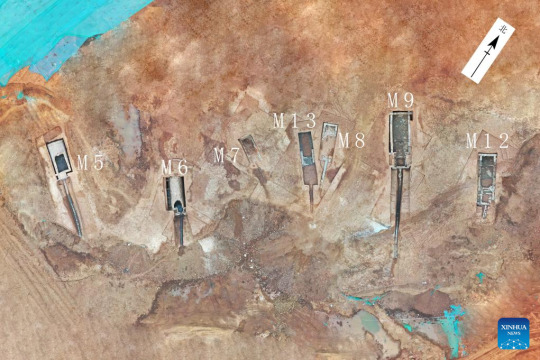
#Ancient Noble Tomb Found in China#Zhenjiang#Jiangsu Province#Six Dynasties period#Zhao Xuanzhi#ancient tomb#ancient grave#ancient artifacts#archeology#archeolgst#history#history news#ancient history#ancient culture#ancient civilizations#ancient china#chinese history#chinese art
32 notes
·
View notes
Text


Rare Silver Coins Dating Back To The 1100s Found in Sweden
From a distance, the slate gray roof and central white tower of the Brahekyrkan church appear charming. The idyllic building is situated on a small island in southern Sweden and surrounded by a cemetery dotted with flowers.
So archaeologists weren’t surprised when a construction project at the church uncovered several skeletons — but the grave held an 800-year-old mystery, too.
Archaeologists began excavations at the Brahekyrkan church in Visingsö to prepare for the installation of a geothermal heating system, the Jönköping County Museum said in a March 27 news release.
On the first day of the excavation, the team found two skeletons, Anna Ödéen, an archaeologist with the museum, said in the release. One belonged to a man between 20 and 25 years old, but the other was not identified.
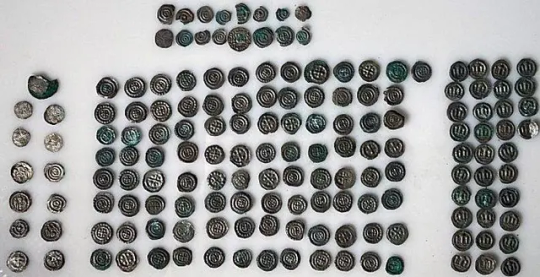
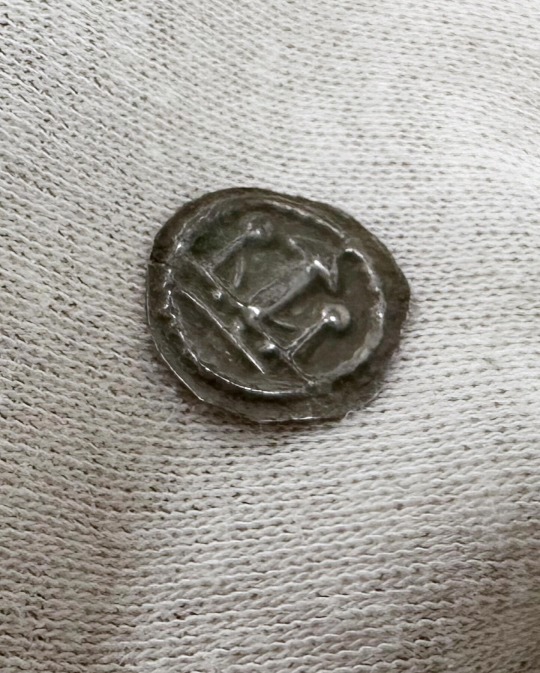
As they cleaned the grave, three silver coins emerged, Ödéen said. Then, more coins surfaced near the skeleton’s left foot.
In total, archaeologists found 170 silver coins dating between 1150 to 1180, the museum said.
Some of the 800-year-old artifacts had completely unknown designs, the museum said. Archaeologists described it as sensational and unique.
The find was also rare because Christian graves during the 12th century typically did not include any artifacts, the museum said. The tradition of burying people with objects was common during older, prehistoric eras.


Archaeologists don’t know why the deceased was buried with the rare coins. Excavations at the church and analyses of the coins are ongoing in hopes of solving this mystery.
Visingsö is an island in southern Sweden and about an 180-mile drive southwest from Stockholm.
By Aspen Pflughoeft.

#Rare Silver Coins Dating Back To The 1100s Found in Sweden#Brahekyrkan church#Visingsö#ancient grave#ancient tomb#silver#silver coins#ancient artifacts#archeology#archeolgst#history#history news#ancient history#ancient culture#ancient civilizations#mideval
39 notes
·
View notes
Text

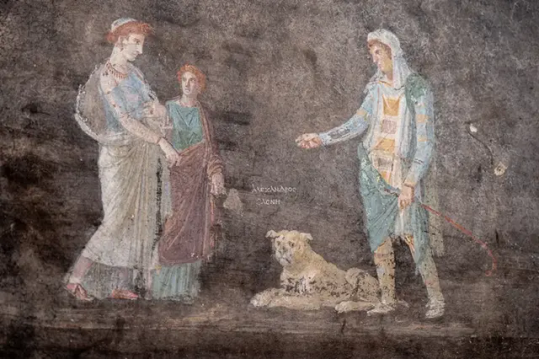
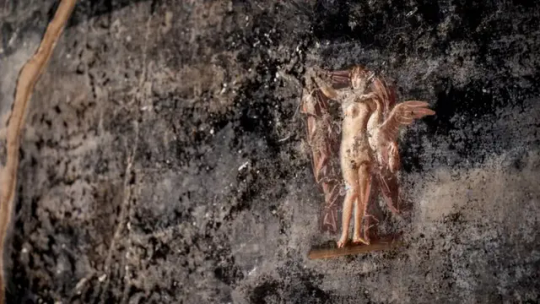
Breathtaking New Frescoes Found at Pompeii
Stunning Roman frescoes have been uncovered by archeologists in Pompeii, the ancient city destroyed by an eruption of the volcano Mount Vesuvius in the year 79 AD. Experts say the newly discovered frescoes are among the finest ever to emerge at the renowned archeological site.
The works of art line the high walls of what was once a large banquet hall. The walls themselves were painted mostly black, and the figures on the frescoes appear to emerge from the shadows. Site director Dr. Gabriel Zuchtriegel told CBS News partner network BBC News that the dark color was likely used to hide stains from the lamps that lit the hall after the sun went down.
"In the shimmering light, the paintings would have almost come to life," Zuchtriegel said.
Two pieces dominate the hall; one depicts the Greek god Apollo trying to seduce the priestess Cassandra. The second piece shows Prince Paris meeting Helen of Troy.


About a third of the "lost city" of Pompeii remains obscured by volcanic debris from the eruption almost two millennia ago. As scientists make new finds, they quickly move them to a storeroom to protect them from the elements.
The newly discovered frescoes, however, cannot be moved, so they have been protected with temporary roofing. Plaster glue is also being injected into the walls behind the artwork to stop them from falling down.
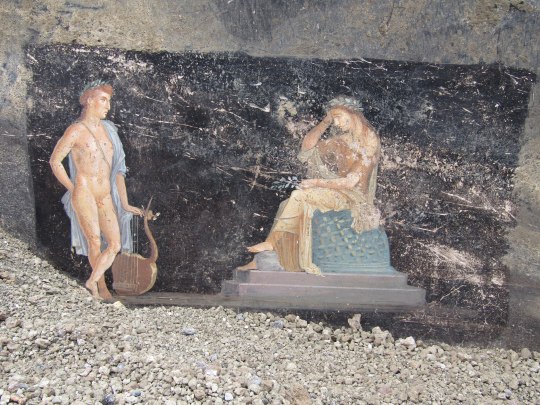
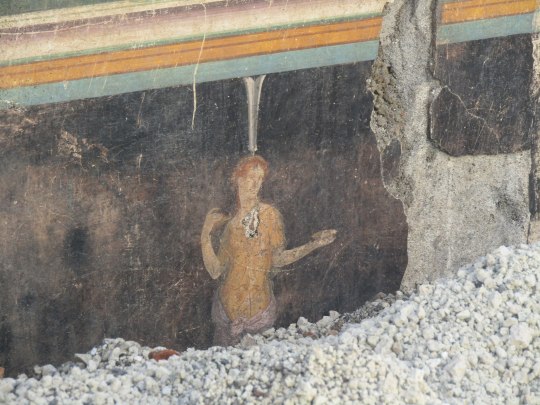

"We have a passion and a deep love for what we're doing, because what we're uncovering and protecting is for the joy also of the generations that come after us," chief restorer Dr. Roberta Prisco told the BBC, adding that the work was very stressful.
The dig site is much bigger than just the banquet hall.
Another fresco recovered from what was once one of Pompeii's grand properties had been on a ceiling, but it was smashed by the eruption that destroyed the city. Archeologists were able to lay out the pieces like a puzzle and recreate landscapes, theatrical masks, and Egyptian characters.


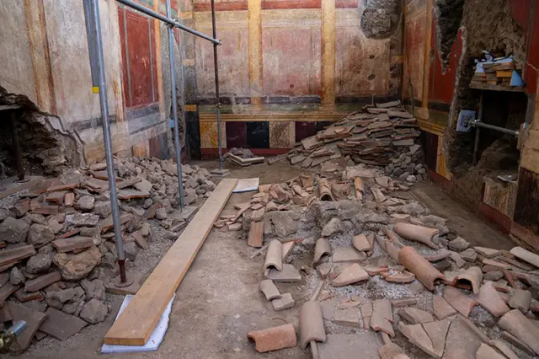
"This is my favorite discovery in this excavation because it is complex and rare," Dr. Alessandro Russo, co-lead archeologist on the dig, told the BBC. "It is high-quality, for a high-status individual."
In a bakery next to the grand property, the skeletons of two adults and a child were discovered.
Archeologists believe they may have been slaves who were trapped and couldn't flee the eruption, and were killed by falling stones.
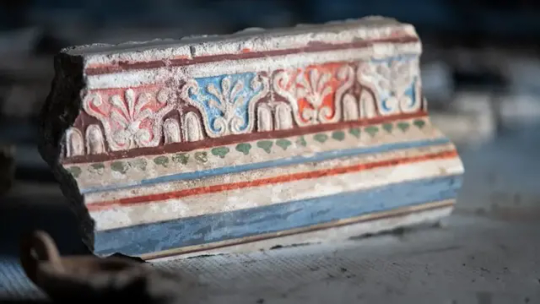
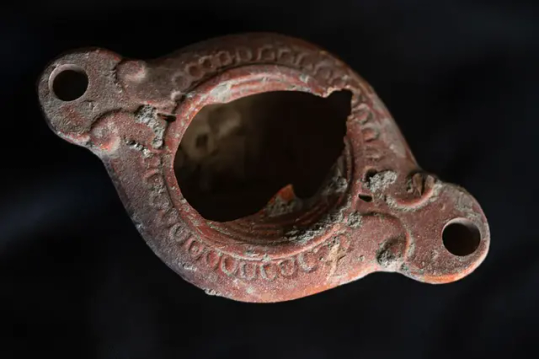
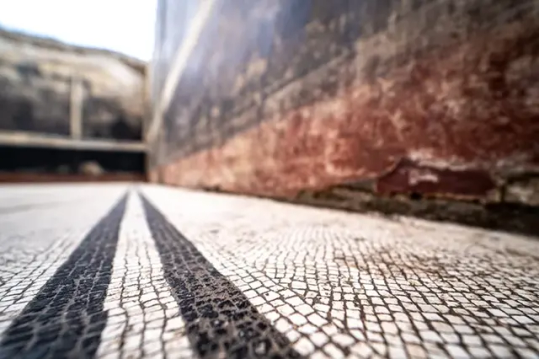
"When we excavate, we wonder what we're looking at," co-lead archeologist Dr. Gennaro Iovino told the BBC. "Much like a theater stage, you have the scenery, the backdrop, and the culprit, which is Mount Vesuvius. The archeologist has to be good at filling in the gaps — telling the story of the missing cast, the families and children, the people who are not there anymore."
The team's discovery was just one of a number of recent revelations from the site, after they found other mythological-themed frescoes in early March and then, just weeks later, a construction site that was being worked on right up until the eruption.
The archeologists said near the end of March that they'd found a home construction project that was frozen in time by the eruption, with materials such as bricks and tools still piled up in the reception area of the home.
By Haley Ott.



#Breathtaking New Frescoes Found at Pompeii#Roman frescoes#Mount Vesuvius#ancient artifacts#archeology#archeolgst#history#history news#ancient history#ancient culture#ancient civilizations#roman history#roman empire#roman art
198 notes
·
View notes
Text








2020 McLaren Senna GTR 'LM 25' by Lanzante
#McLaren Automotive#2020 McLaren Senna GTR 'LM 25' by Lanzante#automobile#car#supercar#British sports car#luxury#luxury car#luxury living#luxury lifestyle#rich#billionaire lifestyle#sexy
15 notes
·
View notes